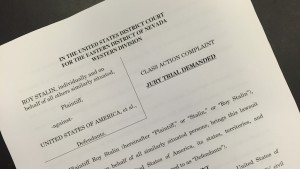Federal Court Ends Dramatic Fight Over Meaning of “Double-Spaced”

So how you view this dispute is going to say an awful lot about how you view the legal profession and even more about whether you want to be a part of it. It may also explain why you read Lowering the Bar, if you do read it and haven't just had this rudely thrust upon you by someone who doesn't value your time. Because this is a classic example.
On the one hand, this was a completely ludicrous court fight that involved nine law firms that combined for 66 pages of briefing, declarations, and exhibits, all inflicted on a federal court because of a dispute over what double-spaced" means. It should never have happened.
On the other hand, this was a completely ludicrous court fight that involved nine law firms that combined for 66 pages of briefing, declarations, and exhibits, all inflicted on a federal court because of a dispute over what double-spaced" means. And it is great that it happened.
There is also a right answer to the underlying question, trivial though it may be, and if you're a lawyer, you really should know it.
This marvelous saga began with the filing of Defendants' Motion to Require Adherence With Formatting Requirements of Local Rule 7.1," and if you ever find yourself seriously considering filing something with that title, please stop. The outrage that prompted this was the plaintiffs' filing of a summary-judgment opposition that, in Defendants' view, failed to comply with said formatting requirements. The Western District of Tennessee's local rules, like those of many courts, require lines to be double-spaced...." But those same rules, like those of many courts, fail to define what double-spaced" means. Thus were laid the foundations of controversy.
In preparing their reply, Defendants said, they discovered that Plaintiffs have with regularity over[ridden] the standard double-space setting and instead spaced lines 24 points apart[!!!]." (They didn't actually use italics or exclamation points, which surprised me a little.) This has enabled Plaintiffs to have approximately 27 lines on each page," they continued, rather than the approximately 23 lines per page that would result from formatting using standard double spacing." This dastardly conduct had enabled them, Defendants claimed, to cram an additional 7.5 pages into their fact statement and 17 additional pages into their opposition brief. This could not be borne.
Part of the problem here is that for some reason not disclosed in the briefing, the court seems to have allowed the lawyers on both sides to file 100-page briefs, and the lawyers actually did so. For this there is no excuse, for anyone involved. That page limit is why the extra four lines per page ended up being so significant overall. But on with our story.
Would I complain about a rule violation that gave the other side almost 20% more pages? Yes, but (1) I would do it in a footnote and more importantly (2) I would make sure I was 100% right. Here, as Plaintiffs pointed out and the court ultimately agreed, Defendants were not right.
To be fair, the court rule doesn't define double-spacing," and as experts have pointed out, when Microsoft Word (the most commonly used word processor) says double-spacing," it doesn't mean double-spacing in the same sense that term had in the typewriter era. In that era, when most court rules were written, double-spacing" meant twice the font size. On a typewriter, each new line is the size of the font. So if the font was 12 points (as it usually was), double-spacing" was 24 points.
Not in Word. In Word, double" line spacing is not twice the font size, it is about 233% of the font size. Why? According to Microsoft (and an exhibit Plaintiffs attached), it just thought the extra space looked better. Maybe it does! But it isn't double" the font size. It isn't double" anything. It's 233% of something. Microsoft can certainly call it double" if it wants to. But it is not, in fact, double.
To get true double-spacing," then, you have to use Word's exactly" line-spacing setting, and set the line spacing to twice whatever font size you're using. Twelve-point font? Exactly 24." Thirteen-point font? Exactly 26." Fourteen-point font, which is an abomination but courts get what they want? Exactly 28." And not only is this consistent with the actual meaning of the English word double," it is the opinion of Matthew Butterick, a lawyer/typographer (really) who has written a great book called Typography for Lawyers. (I'm being serious here-it's great.) Plaintiffs not only attached the section of his book on this very question, they had him submit an expert declaration on the subject-complete with an image of him using a ruler to measure the lines in Plaintiffs' brief.
Butterick's involvement is probably one reason Plaintiffs won the debate. On November 14, the court denied Defendants' motion. It acknowledged that courts have taken different approaches to this issue (citing two cases), and that the issue of what constitutes a double space has not [yet] been raised in this district." It therefore found that, under the circumstances, Plaintiffs had not violated the local rule.
However," it continued, in so finding, the Court does not take a position on the correct definition of double spaced.'" One reason for this (not mentioned) is that some people do still use typewriters, not word processors. But more to the point, as the Court said, the last thing any party needs is more words on a page." (Especially when they apparently have 100 pages to work with.) The length of an argument is no guarantee of its success.... Moving forward, the Parties are encouraged to spend their valuable time focusing on the merits of this case, and certainly not figuring out how many sometimes-useless words will fit on a page."
So ordered.
Credit to legal-writing expert Ross Guberman, who posted a link to this on the site formerly known as Twitter.







